王蔷《英语教学法教程》笔记和课后习题(含考研真题)详解-第7~10章【圣才出品】
王蔷《英语教学法教程》笔记和课后习题(含考研真题)详解(交际教学原则与任务型语言教学)【圣才出品】
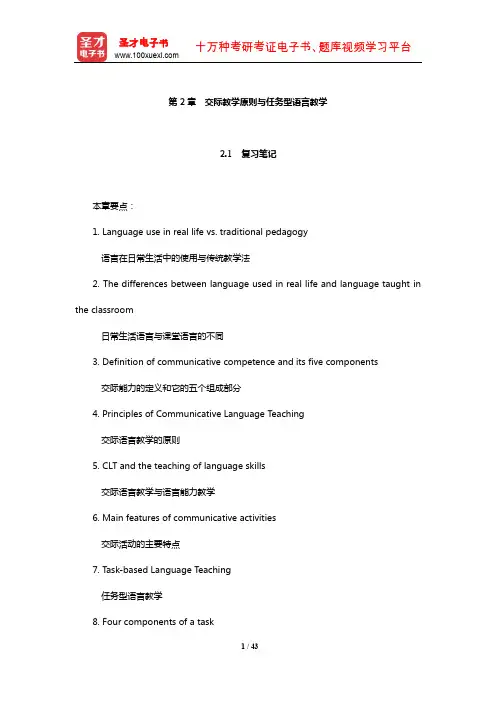
第2章交际教学原则与任务型语言教学2.1 复习笔记本章要点:1. Language use in real life vs. traditional pedagogy语言在日常生活中的使用与传统教学法2. The differences between language used in real life and language taught in the classroom日常生活语言与课堂语言的不同3. Definition of communicative competence and its five components交际能力的定义和它的五个组成部分4. Principles of Communicative Language Teaching交际语言教学的原则5. CLT and the teaching of language skills交际语言教学与语言能力教学6. Main features of communicative activities交际活动的主要特点7. T ask-based Language Teaching任务型语言教学8. Four components of a task任务的四个部分9. PPP and T ask-based Language Teaching介绍,练习和产出与任务型语言教学10. The steps to design tasks设计任务的步骤11. Appropriateness of CLT and TBLT in the Chinese context交际语言教学的恰当性和中文环境的任务型语言教学本章考点:语言在日常生活中的使用与传统教学法;日常生活语言与课堂语言的不同;交际能力的定义和它的五个组成部分;交际语言教学的原则;交际语言教学与语言能力教学;交际活动的主要特点;任务型语言教学;任务的四个部分;介绍,练习和产出与任务型语言教学的不同;设计任务的步骤;交际语言教学的恰当性和中文环境的任务型语言教学。
王蔷《英语教学法教程》笔记和课后习题(含考研真题)详解(英语教育资源的开发与利用)【圣才出品】
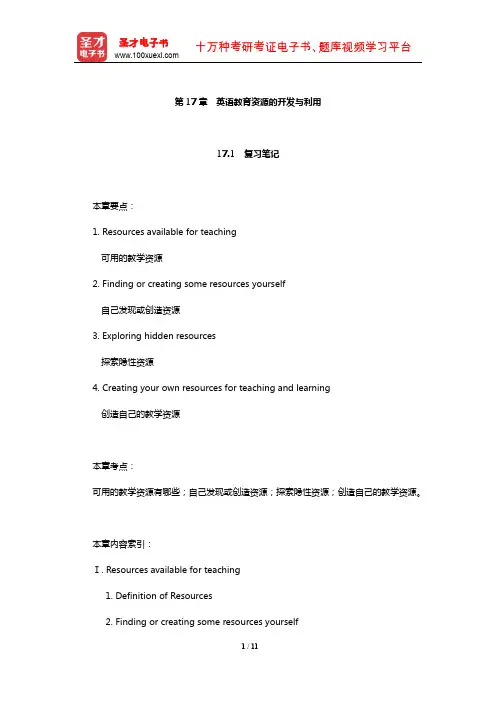
第17章英语教育资源的开发与利用17.1 复习笔记本章要点:1. Resources available for teaching可用的教学资源2. Finding or creating some resources yourself自己发现或创造资源3. Exploring hidden resources探索隐性资源4. Creating your own resources for teaching and learning创造自己的教学资源本章考点:可用的教学资源有哪些;自己发现或创造资源;探索隐性资源;创造自己的教学资源。
本章内容索引:Ⅰ. Resources available for teaching1. Definition of Resources2. Finding or creating some resources yourselfⅡ. Exploring hidden resourcesⅢ. ConclusionⅠ.Rsources available for teaching(可用的教学资源)1. Definition of Resources(教学资源的定义)It refers to books, any person, animals, or any object, that make teaching and learning easier, clearer and more interesting. Obviously, in teaching English, we will need different kinds of resources to make our teaching more effective. Some publishers nowadays provide teachers with a package of materials which include flashcards, pictures, storybooks, tapes or CD-ROMs.教学资源主要包括课本、人、动物以及任何让教学更简单、更清晰、更有趣的物体。
王蔷《英语教学法教程》笔记和课后习题(含考研真题)详解(口语教学)【圣才出品】
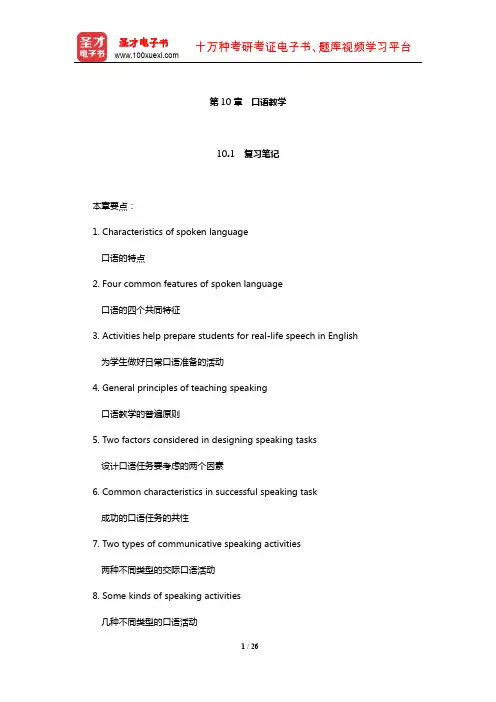
第10章口语教学10.1 复习笔记本章要点:1. Characteristics of spoken language口语的特点2. Four common features of spoken language口语的四个共同特征3. Activities help prepare students for real-life speech in English 为学生做好日常口语准备的活动4. General principles of teaching speaking口语教学的普遍原则5. Two factors considered in designing speaking tasks设计口语任务要考虑的两个因素6. Common characteristics in successful speaking task成功的口语任务的共性7. Two types of communicative speaking activities两种不同类型的交际口语活动8. Some kinds of speaking activities几种不同类型的口语活动9. Advantages of using group in speaking tasks使用分组教学的优势本章考点:口语的特点及对教学的暗示;口语的四个共同特征;为学生做好日常口语准备的活动;口语教学的普遍原则;设计口语任务要考虑的两个因素;成功的口语任务的共性;两种不同类型的交际口语活动;几种不同类型的口语活动;使用分组教学的优势。
本章内容索引:Ⅰ. Differences between spoken and written language1. Characteristics of spoken language2. Four common features of spoken language3. Activities helpful to prepare students for real-life speech in English4. Some implications to teachingⅡ. Principles for teaching speakingⅢ. Designing speaking tasks1. Two factors considered in designing speaking tasks2. Common characteristics in successful speaking tasksⅣ.Types of speaking tasks1. Two major purposes for listening2. Two types of communicative speaking activities3. Some kinds of speaking activities4. Other speaking activitiesⅤ.Organizing speaking tasksⅥ.ConclusionⅠ.Differences between spoken and written language (口语与书面语的区别)【考点:口语的特点及对教学的暗示】Speaking is a skill that the students will be judged upon most in real-life situations.口语是用来判断学生在实际生活中使用最多的技能。
王蔷《英语教学法教程》笔记和课后习题(含考研真题)详解-第11~13章【圣才出品】
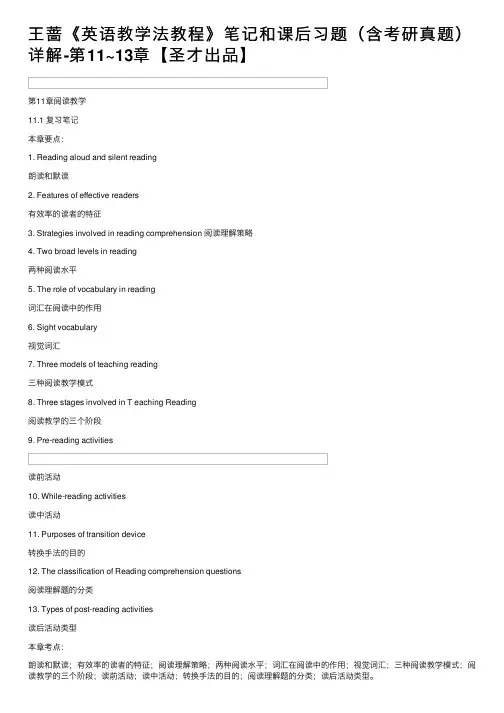
王蔷《英语教学法教程》笔记和课后习题(含考研真题)详解-第11~13章【圣才出品】第11章阅读教学11.1 复习笔记本章要点:1. Reading aloud and silent reading朗读和默读2. Features of effective readers有效率的读者的特征3. Strategies involved in reading comprehension 阅读理解策略4. Two broad levels in reading两种阅读⽔平5. The role of vocabulary in reading词汇在阅读中的作⽤6. Sight vocabulary视觉词汇7. Three models of teaching reading三种阅读教学模式8. Three stages involved in T eaching Reading阅读教学的三个阶段9. Pre-reading activities读前活动10. While-reading activities读中活动11. Purposes of transition device转换⼿法的⽬的12. The classification of Reading comprehension questions阅读理解题的分类13. Types of post-reading activities读后活动类型本章考点:朗读和默读;有效率的读者的特征;阅读理解策略;两种阅读⽔平;词汇在阅读中的作⽤;视觉词汇;三种阅读教学模式;阅读教学的三个阶段;读前活动;读中活动;转换⼿法的⽬的;阅读理解题的分类;读后活动类型。
本章内容索引:Ⅰ. Reflecting on your own reading experiencesⅡ. The way of reading1. Reading aloud and silent reading2. Features of effective readersⅢ. The content of readingⅣ. Strategies involved in reading comprehension1. Definition of reading2. Two broad levels in readingⅤ. The role of vocabulary in reading1. The importance of vocabulary2. Sight vocabularyⅥ. Principles and models for teaching reading1. Three models of teaching reading2. Three stages involved in teaching reading Ⅶ. Pre-reading activities1. Definition of pre-reading activities2. Predicting3. Setting the scene4. Skimming5. Scanning6. Summary on pre-reading activitiesⅧ. Whi le-reading activities1. Information transfer2. Purposes of transition device3. Reading comprehension questions4. Understanding references5. Making inferences6. Summary on while-reading activitiesⅨ. Post-reading activities1. Objectives2. Requirements3. Types of post-reading activitiesⅩ. ConclusionⅠ. Reflecting on your own reading experiences (反思⾃⼰的阅读经验)All of us began reading in our first language at a very early age and we all have experiences of being influenced by certain authors or particular books.我们在很⼩的时候开始⽤母语阅读了,我们都受到某些作者或书籍的影响。
王蔷《英语教学法教程》笔记和课后习题(含考研真题)详解(语音教学)【圣才出品】
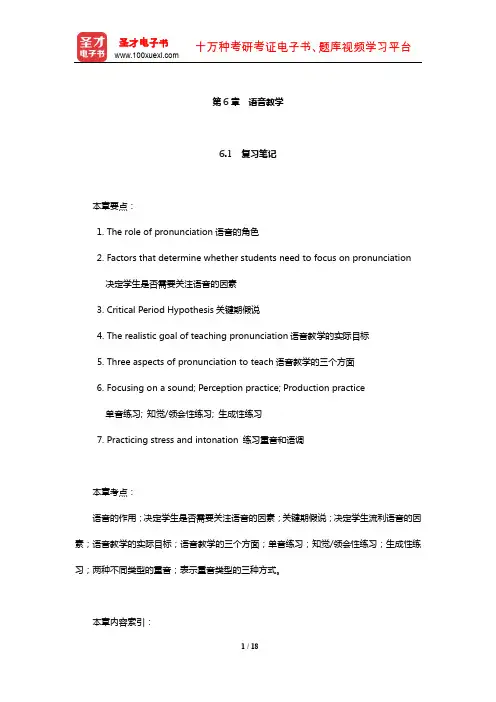
第6章语音教学6.1 复习笔记本章要点:1. The role of pronunciation语音的角色2. Factors that determine whether students need to focus on pronunciation决定学生是否需要关注语音的因素3. Critical Period Hypothesis关键期假说4. The realistic goal of teaching pronunciation语音教学的实际目标5. Three aspects of pronunciation to teach语音教学的三个方面6. Focusing on a sound; Perception practice; Production practice单音练习; 知觉/领会性练习; 生成性练习7. Practicing stress and intonation 练习重音和语调本章考点:语音的作用;决定学生是否需要关注语音的因素;关键期假说;决定学生流利语音的因素;语音教学的实际目标;语音教学的三个方面;单音练习;知觉/领会性练习;生成性练习;两种不同类型的重音;表示重音类型的三种方式。
本章内容索引:Ⅰ. The role of pronunciationⅡ. The goal of teaching pronunciation1. Critical Period Hypothesis2. Factors that determine if the students can aquire native-like English pronunciation3. The realistic goal of teaching pronunciationⅢ. Aspects of pronunciation1. Three aspects of pronunciation to teach2. One common problem in learning pronunciationⅣ. Practicing sounds1. Focusing on a sound2. Perception practice3. Production practiceⅤ. Practicing stress and intonation1. Practicing stress2. Practicing intonationⅥ. ConclusionⅠ. The role of pronunciation(语音的作用)【考点:语音的作用;决定学生是否需要关注语音的因素】Whether pronunciation needs special attention or focus in language teaching depends on many factors, especially learner factors.语言教学中是否需要特别关注语音取决于许多因素,尤其是学习者因素。
王蔷《英语教学法教程》笔记和课后习题(含考研真题)详解(词汇教学)【圣才出品】
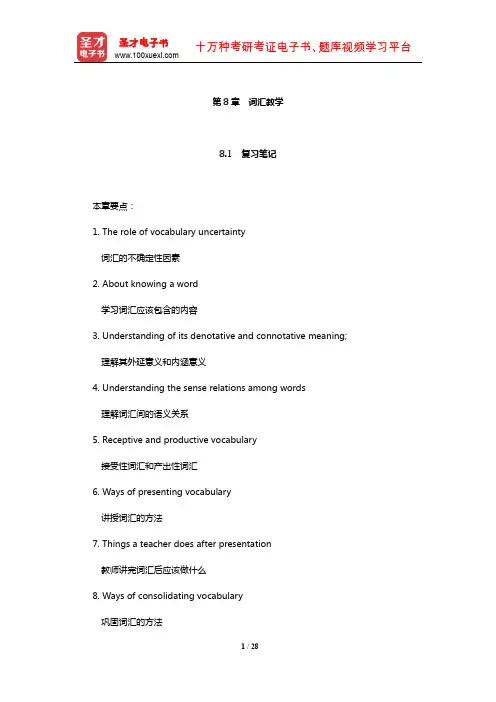
第8章词汇教学8.1 复习笔记本章要点:1. The role of vocabulary uncertainty词汇的不确定性因素2. About knowing a word学习词汇应该包含的内容3. Understanding of its denotative and connotative meaning; 理解其外延意义和内涵意义4. Understanding the sense relations among words理解词汇间的语义关系5. Receptive and productive vocabulary接受性词汇和产出性词汇6. Ways of presenting vocabulary讲授词汇的方法7. Things a teacher does after presentation教师讲完词汇后应该做什么8. Ways of consolidating vocabulary巩固词汇的方法9. Developing vocabulary learning strategies发展词汇学习策略本章考点:理解词汇和词汇学习;词汇的不确定性因素;学习词汇应该包含的内容;词汇的学习;接受性词汇和产出性词汇;讲授词汇的方法;教师讲完词汇后应该做什么;巩固词汇的方法;词汇学习的策略。
本章内容索引:Ⅰ. Understanding vocabulary and vocabulary learningⅡ. About knowing a word1. Knowing a word2. Vocabulary learningⅢ. Ways of presenting vocabulary1. The methods to present and explain vocabulary2. Things a teacher does after presentationⅣ. Ways of consolidating vocabularyⅤ. Developing vocabulary learning strategies1. Review regularly2. Guess meaning from context3. Organize vocabulary effectively4. Use a dictionary5. Manage strategy useⅥ. ConclusionⅠ. Understanding vocabulary and vocabulary learning (理解词汇和词汇学习)【考点:理解词汇和词汇学习;词汇的不确定性因素】The role of vocabulary seems to have received more consistent understanding.大家对词汇的角色的认识基本上是一致的。
王蔷《英语教学法教程》笔记和课后习题(含考研真题)详解-第1~3章【圣才出品】
第1章语言和语言学习1.1 复习笔记本章要点:1. The way we learn languages我们习得语言的方式2. Views on language语言观点3. The structural view of language结构主义语言理论4. The functional view of language功能主义语言理论5. The interactional view of language交互语言理论6. Common views on language learning关于语言学习的普遍观点7. Process-oriented theories and condition-oriented theories 强调过程的语言学习理论和强调条件的语言学习理论8. The behaviorist theory行为主义学习理论9. Cognitive theory认知学习理论10. Constructivist theory建构主义学习理论11. Socio-constructivist theory社会建构主义理论12. Qualities of a good language teacher一个好的语言老师必备的素养13. Teacher’s professional development教师专业技能发展本章考点:我们如何习得语言;结构主义语言理论;功能主义语言理论;交互语言理论;关于语言学习的普遍观点;强调过程的语言学习理论和强调条件的语言学习理论;行为主义学习理论;认知学习理论;建构主义学习理论;社会建构主义理论;成为一个好的语言老师所要具备的基本素质;教师专业技能发展图。
本章内容索引:Ⅰ. The way we learn languagesⅡ. Views on language1. The structural view of language2. The functional view of language3. The interactional view of languageⅢ. Views on language learning and learning in general1. Research on language learning2. Common views on language learning and learning in general(1)Behaviorist theory(2)Cognitive theory(3)Constructivist theory(4)Socio-constructivist theoryⅣ. Qualities of a good language teacherⅤ. Development of a good language teacherⅥ. An overview of the bookThis chapter serves as an introduction for setting the scene for this methodology course. It discusses issues concerning views on language and language learning or learning in general with the belief that such views will affect teachers’ ways of teaching and thus learners’ ways of learning. The qualities of a good language teacher are also discussed in order to raise the participants’ awareness of what is required for a good English teacher.这一章主要是介绍教学法的方法论,其中讨论的问题涉及语言和语言学习的观点,或者一般学习及这些观点对教师教学方式和学习者学习方式的影响,本章也讨论了一个好的英语教师应具备的素质,以提高语言教学参与者对优秀英语教师相关要求的意识。
王蔷《英语教学法教程》配套题库【章节题库】(口语教学)【圣才出品】
王蔷《英语教学法教程》配套题库【章节题库】(口语教学)【圣才出品】第10章口语教学Ⅰ. Fill in the blanks.1. Maximum foreign talk, even participation, _____, and _____ are the four characteristics which are common in successful speaking tasks.【答案】high motivation,right language level【解析】成功的口语任务具有四个常见的特征:尽量用外语交谈、公平参与、高度的动机、合适的语言水平。
2. One of the characteristics of speech in everyday life is that speech is _____. That is, in most situations, people do not plan ahead of time what they are going to say. 【答案】spontaneous 【解析】即时性是日常口语的特征之一;也就是说,在大多数情况下,人们不会提前计划好将要说什么。
3. One advantage in learning to speak compared with learning to write is that the speaker gets immediate feedback from the _____, so the speaker can adjust the message immediately.【答案】listener【解析】和写作学习相比,口语学习的优势是说话者可以从听话者那里获得即时的反馈,因而可以立即调整话语。
4. For most students who are learning English in schools in China, the _____ is perhaps the major if not the only place for them to encounter English.【答案】classroom【解析】对于大多数在国内学校学习英语的学生而言,教室倘若不是唯一使用英语的场所,也是主要的场所。
王蔷《英语教学法教程》课后习题详解-第1~9章【圣才出品】
第1章语言和语言学习TASK 1Below is a list of interview questions on how people learn a foreign language. In the first column, write down your own responses. Then interview three other students in your class and enter their responses in the other columns. Discuss your findings in groups of 4 and draw some conclusions.(Free answer.)TASK 2Work in groups of 4, brainstorm possible answers to the question: What is language? When you are ready, join another group and share your ideas.Key: Here are sample definitions of “language”found in dictionaries and linguistics books.·Language is a system of arbitrary, vocal symbols which permit all people in a given culture, or other people who have learned the system of that culture, tocommunicate or to interact. (Finocchiaro, 1964:8)·Language is any set or system of linguistic symbols as used in a more or less uniform fashion by a number of people who are thus enabled to communicate intelligibly with one another. (Random House Dictionary of the English Language 1966:806)·Language is a system of arbitrary vocal symbols used for human communication. (Wardhaugh, 1972:3)·Language is a systematic means of communicating ideas or feelings by the use of conventionalized signs, sounds, gestures, or marks having understood meanings. (Webster’s 3rd New International Dictionary of the English Language 1993:1270) ·Language is a system of communication consisting of a set of small parts and a set of rules which decide the ways in which these parts can be combined to produce messages that have meaning. (Cambridge International Dictionary of English 1995:795)•Language is a system of communication by written or spoken words, which is used by the people of a particular country or area.(Longman Dictionary of Contemporary English)•Language is the system of communication in speech and writing that is used by people of a particular country or area. (Oxford Lear ners’ Dictionary)TASK 31) What are the psycholinguistic and cognitive processes involved in languagelearning?2) What are the conditions that need to be met in order for these learning processes to be activated?Work in groups of 4. Brainstorm the answers to the two questions stated above.When you are ready, join another group and share your ideas.Key: 1) Generally speaking, psycholinguistic and cognitive process involved in language learning are concerned with how the mind organizes new information such as habit formation, induction, making inference, hypothesis, testing and generalization.2) To activate these learning process, physical environment for learning is important, including the number of students, the kind of input learners receive and the atmosphere.TASK 4Work in groups. Reflect on your own learning experiences from early school years to the university. Have you had an excellent English teacher? Try to identify as many qualities as possible of your best English teacher(s). Note down all the qualities that you think are important for a good English teacher.Key: Ethic devotion (responsible, warm-hearted, well-prepared, hard-working, etc.), professional qualities(an excellent command of English, professionally-trained) and personal styles(enthusiastic, humourous, attentive, etc. ) jointly contribute tomaking a good teacher.TASK 5Ethic devotion, professional qualities and personal styles jointly contribute to the making of a good English teacher. All the adjectives in the box below could be used to characterize these three aspects.1. Work in groups of 4 and decide which adjectives describe ethic devotion, which describe personal styles and which describe professional qualities. Please write your answers on a separate piece of paper.2. Add any adjectives to the list which describe further qualities that you feel are missing.3. These adjectives are intended to describe positive qualities or styles. Do you feel that any of them could have a negative side as well? If yes, in what way? For example, an authoritative teacher may make the students feel assured, but may also make the student less free to disagree with him/her.Key: Students’ classification will vary. Please note there is no correct or wrong answer for this task.1.2. The adjectives added are marked in italics in the table above.3. Every coin has two sides. An intuitive teacher may save himself or herselffrom the trouble of referring to books, but it may also give students the wrong impression that they can get right by constant guessing, which is unreliable because intuition is often changeable and unstable. Likewise, a humorous teacher will liven up the atmosphere in class, but students are likely to be distracted by jokes or interesting stories, so much that they care little about learning.TASK 6Work in pairs and discuss how one can become a professionally competent teacher of English. For example, we have to develop our English proficiency first and also we may need to learn from experienced teachers through observations. What else can you think of? Make a list and then pool all your ideas together to find out about your common beliefs.Key: To learn teaching theory; to practice teaching skills; to combine theoreticallearning with teaching practice; to reflect teaching experiences; to learn from one’s own experiences as a learner; to learn from colleagues; to have a needs analysis of students; to solve learning and teaching difficulties through researches; to bear in mind the idea of constant improvement.TASK 7Work in groups. Discuss possible answers to the following questions in relation to the model presented in Figure 1.1.Figure 1.1Key: 1. Stages 1 and 2 are interrelated by a double arrow line because neither of the two stages is really ever terminated. Teachers should always make a point of updating their command of English because language is always changing and they may also forget previous knowledge. This can be done while they are teaching, but very often teachers take time off to have further training in English. This is especially important for teachers who do not have enough exposure to English.2. Practice and reflection are connected by a circle because they are neither independent or separate sub-stages. Teachers do not teach one week and then reflect one week. Rather, they teach and reflect on a daily basis. Besides, practice and reflection complement each other and reciprocate each other. Reflection。
王蔷《英语教学法教程》笔记和课后习题(含考研真题)详解(国家英语课程标准)【圣才出品】
第3章国家英语课程标准3.1 复习笔记本章要点:1. Syllabus and curriculum教学大纲和课程设置2. A brief history of foreign language teaching in China中国外语教学简史3. Designing principles for the National English Curriculum国家英语课程设置原则4. Goals and objectives of English language teaching英语语言教学的目标5. Design of the National English Curriculum国家英语课程的设置6. Challenges facing English language teachers英语语言教师所面临的挑战本章考点:教学大纲和课程设置;中国外语教学简史;国家英语课程设置原则;英语语言教学的目标;英语语言教师所面临的挑战和解决办法。
本章内容索引:Ⅰ. A brief history of foreign language teaching in China1. The differences between syllabus and curriculum2. Foreign language teaching in ChinaⅡ. Designing principles for the National English CurriculumⅢ. Goals and objectives of English language teachingⅣ. Design of the National English CurriculumⅤ. Performance standards for different levels of competenceⅥ. Challenges facing English language teachersⅦ. ConclusionⅠ. A brief history of foreign language teaching in China(中国外语教学简史)1. The differences between syllabus and curriculum教学大纲和课程设置的不同A syllabus is a specification of what takes place in the classroom, which usually contains the aims and contents of teaching and sometimes contains suggestions of methodology.教学大纲具体规定了课堂教学内容,通常包括对于教学目标和教学内容,有时还包括教学方法的建议。
- 1、下载文档前请自行甄别文档内容的完整性,平台不提供额外的编辑、内容补充、找答案等附加服务。
- 2、"仅部分预览"的文档,不可在线预览部分如存在完整性等问题,可反馈申请退款(可完整预览的文档不适用该条件!)。
- 3、如文档侵犯您的权益,请联系客服反馈,我们会尽快为您处理(人工客服工作时间:9:00-18:30)。
第7章语法教学7.1 复习笔记本章要点:1. The role of grammar in language learning语法在语言教学中的角色2. Grammar presentation: the deductive method; the inductive method; the guided discovery method 演示法:演绎法,归纳法和引导发现法3. Distinction between implicit and explicit knowledge隐性知识与显性知识的差异4. New approaches to teaching grammar新的语法教学5. Grammar practice: Mechanical practice; Meaningful practice; Using prompts for practice语法练习:机械性练习;意义性练习;使用提示本章考点:语法在语言教学中的角色;演示法:演绎法,归纳法和引导发现法及它们的优缺点;隐性知识与显性知识的差异;新的语法教学;语法练习:机械性练习;意义性练习;使用提示。
本章内容索引:Ⅰ. The role of grammar in language learningⅡ. Grammar presentation1. The deductive method2. The inductive method3. The guided discovery method4. Distinction between implicit and explicit knowledge5. New approaches to teaching grammarⅢ. Grammar practice1. Mechanical practice2. Meaningful practice3. Using prompts for practiceⅣ. ConclusionⅠ. The role of grammar in language learning(语法在语言教学中的角色)【考点:语法在语言教学中的角色】Despite many different views about the role of grammar in language learning, the importance of grammar cannot be denied. Grammatical competence is essential for communication.人们对语法在外语教学中的价值众说纷纭,意见不一,尽管如此,语法的重要性是不言而喻的。
交际活动中的语法能力是必不可少的。
Grammar teaching depends on certain variables (learner and instructional)inthe language teaching/learning context.语法教学取决于语言教学或学习情境中的特定因素,如学习者因素和教学因素。
As research indicates, grammar instruction should be mainly implicit, supported by explicit instruction. At the beginning stage, it is better to adopt mainly the implicit approaches, and as students progress, the ratio of explicit instruction can be increased.研究表明,语法教学应该以隐性教学为主,显性教学为辅。
在初学阶段,最好以隐性教学为主。
随着学生逐渐进步,显性教学的比例可以适当增加。
The best approach is the combination of both implicit and explicit instruction.最好的方法是隐性教学和显性教学相结合。
Ⅱ. Grammar presentation(语法展示)【考点:演示法:演绎法,归纳法和引导发现法及其优缺点;隐性知识与显性知识的差异;新的语法教学】There are different ways of presenting grammar in the classroom. Among them, three are most frequently used and discussed.课堂教学中有不同的展示语法的方法,其中有三种方法是最常用的:1. The deductive method(演绎法)The deductive method relies on reasoning, analyzing and comparing.演绎法建立在推理、分析、比较的基础上。
Teaching procedure:teacher’s example s on the board, teacher’s explanation of the rules (in student’s native language), student’s practice application of therules.教学步骤:老师把例子写在黑板上,并用学生本族语解释规则,学生练习使用这些规则。
Advantages(优点)good for selected and motivated students;适合优等生和积极性高的学生;save time to explain complex rules;节约解释复杂规则的时间;increase students’ confidence in examination.增强学生考试的自信心。
Disadvantages(缺点)grammar is taught isolatedly; 孤立讲授语法;little attention is paid to meaning; 很少关注意义;the practice is often mechanical. 机械练习。
2. The inductive method(归纳法)The teacher provides learners with authentic language data and induces the learners to realize grammar rules without any form of explicit explanation.教师提供给学生真实的语言数据,引导学生在没有任何形式的明确解释时意识到语法规则。
Teaching procedure(教学步骤)authentic language presentation(give grammar examples);呈现真实的语言(给出语法例子);let students observe, analyze, compare examples;让学生观察、分析、对比例子;help students induct grammar rules.帮助学生感应语法规则。
Advantages(优点)inspire students’ thinking activities;激发学生思考;motivate students’ learning interests;提升学生的学习兴趣;grammar is taught in context.在一定语境中教授语法。
Disadvantages(缺点)The presentation of grammar is more complex and time consumption is huge;语法教学更加复杂,大量耗费时间;grammar is not taught directly;间接讲授语法;some rules can not be induced easily.不易归纳语法规则。
3. The guided discovery method(引导发现法)Similar to the inductive method: the students are induced to discover rules by themselves (similar);The process of the discovery is carefully guided and assisted by the teacher and the rules are then elicited and taught explicitly.(different)与归纳法相类似,引导学生发现语法规则;不同的是:老师仔细地指导、帮助学生发现、引出语法规则,并对其做出明确讲授。
4. Distinction between implicit and explicit knowledge(隐性知识与显性知识的差异)Implicit knowledge refers to knowledge that unconsciously exists in our mind, which we can make use of automatically without making any effort. (our first language knowledge).隐性知识指的是我们头脑中的无意识的知识,我们不用做任何努力自动利用的知识。
(母语知识就是隐性知识)。
Explicit knowledge refers to our conscious knowledge about the language. We can talk about it, analyze it and apply it in conscious ways. (second language acquisition theory).显性知识指的是可以意识到的语言知识,我们可以谈论、分析并有意识的利用的知识(第二语言知识)。
In practice, learner variables and instructional variables need to be considered when teachers decide which method to use in presenting a particular grammatical structure.在教学实践中,教师在决定采用哪种方式呈现语法结构时,要考虑学习者因素和教学因素。
5. New approaches to teaching grammar(新的语法教学)Synthesis approach(by Pennington): grammar teaching should be ‘collocational, constructive, contextual and contrasti v e’, which can serve as useful guidelines for teaching grammar.合成法:语法教学应该是一致的、建设性的、一定语境的和对比性的。
